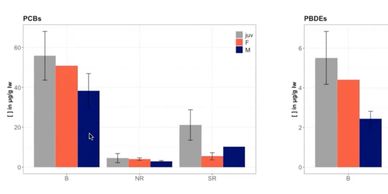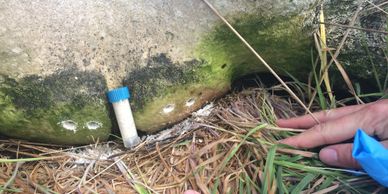Conference papers
Deep Incomplete Classifiers for Killer Whale Photo-ID
Deep Incomplete Classifiers for Killer Whale Photo-ID
Deep Incomplete Classifiers for Killer Whale Photo-ID

Abstract
Machine-assisted photo identification processes require significant amounts of data for each member of a population of interest but offer the possibility to alleviate a significant amount of manual effort. Gathering such data is time consuming and opportunistic, leading to imbalanced datasets ill-suited for traditional machine (deep) learning efforts. Incomplete classifiers, trained on a subset of classes in a population,
can be initially useful to identify the most commonly seen individuals. This study investigates the use of incomplete classifiers trained on a subset of often-observed individual killer whales to generate latent space representations of the larger population containing unseen individuals. These semantically relevant representations are subsequently clustered to investigate the efficacy of this method as a secondary identification mechanism. This method proves to be robust to a significant amount of noise while being able to isolate individuals unknown to the classifier when applying limited expert knowledge to the approximate size of the population.
Contaminants in Resident and Bigg's Killer Whales
Deep Incomplete Classifiers for Killer Whale Photo-ID
Deep Incomplete Classifiers for Killer Whale Photo-ID

Noel, M., DeCourten, B., Ylitalo, G., Hanson, B., Ross, P.S., Towers, J.R. and Barrett-Lennard, L. 2022. Update on levels of legacy and emerging contaminants of concern in resident and Bigg's killer whale populations. Virtual Salish Sea Ecosystem Conference 2022.
Abstract
Exposure to contaminants is a significant threat to three populations of killer whales
(Orcinus orca) inhabiting the transboundary waters of British Columbia, Canada and Washington State, USA. While the southern resident population is listed as Endangered under both the Species at Risk Act (SARA) in Canada and the U.S. Endangered Species Act (ESA), both the northern resident and Bigg’s killer whales are listed as Threatened under SARA. The Canadian Technical Working Group for the recovery of southern resident killer whales has identified polychlorinated biphenyls (PCBs), polybrominated diphenyl ethers (PBDEs), perfluoro octanoic acid (PFOA), perfluoro octane sulfonate (PFOS), dichloro diphenyl trichloroethane (DDT) and dieldrin as major contaminants of concern for the recovery of the population. While PCBs and PBDEs have been monitored extensively in the three populations of killer whales, there is little to no information available on pesticides and fluorinated compounds. In the present study, we collected blubber/skin biopsies from southern residents (2015; n = 8), northern residents (2019 – 2021; n = 8) and Bigg’s killer whales (2019 – 2021; n = 12). PCBs, PBDEs, PFOA, PFOS, DDT and dieldrin were analysed using high resolution mass chromatography / high resolution mass
spectrometry. Analyses are currently underway to determine total concentrations and contaminant patterns. We will evaluate differences amongst populations and sexes as well as compare the levels of contaminants to Toxicity Reference Values (TRVs) when available. This study will provide new essential information on the current levels of important legacy and emerging contaminants in these three populations of killer whales and will help inform the development and application of recovery action plans.
The Yukusam Story
Deep Incomplete Classifiers for Killer Whale Photo-ID

Abstract
From 11 February to 31 March 2018, a lone male sperm whale visited coastal waters from the northeast to southern ends of Vancouver Island. This whale, named "Yukusam" after the Namgis First Nation word for Hanson Island, near where the whale was first observed and recorded, is the first sperm whale recorded acoustically in the area since 1984 and is the only sperm whale ever observed in coastal waters between Vancouver Island and continental North America. The Yukusam tracking story is a showcase for the potential of acoustic observatory collaborations. Tracking a single animal over such time and distance is remarkable. It obviously helped that Yukusam was the only sperm whale in the area, but still, the experience hints at the potential for using diverse independent observatories collaboratively. We then aim to see all the observatories running automated detection classification and location software and having all the data tied in to a public database for a total of almost 500 Gb of recordings, with labels. Supplemental material @ http://sabiod.org/yukusam
Sperm Whale IPIs

Abstract
Yukusam is the name given to a male sperm whale who was first documented off northeastern Vancouver Island in February 2018. He spent several weeks in this area before traveling south to the inland waters of the Salish Sea in late March 2018. Sperm whale clicks have been used as a proxy to determine overall size by using the time difference of arrival between the initial noise pulse and its reflections within the spermaceti organ. Different equations have been derived in order to use this Inter-Pulse Interval (IPI) to estimate overall length. Here we use Yukusam’s usual clicks recorded from the Lime Kiln hydrophone on the west side of San Juan Island (WA State, USA) to compare IPI-based length estimates with visual observations. Photo and video documentation indicate that this whale is ~15 m in length. Our initial acoustic results indicate that equations in the literature underestimate his length by at least a few meters. The potential reasons behind these anomalies are explored in this presentation.
Genetic Diversity and Trophic Ecology of Sei Whales

Abstract
A good understanding of the historic distribution, structure and ecology of a given population provides a vital baseline for determining recovery rates and informing population assessments for conservation management. Despite extensive whaling records providing information on species distributions prior to exploitation, the genetic diversity, structuring and trophic niche of the Southern Hemisphere sei whale (Balaenoptera borealis) is relatively unknown. Sei whaling at the Falkland Islands (Islas Malvinas) was intense in the early 20th century, leaving many whalebones discarded on beaches in the vicinity of the local whaling station. Now, sei whales are regularly seen in local waters and have been studied there since January 2017. Using a combination of whalebones and modern samples (collected 2017-2018) we analyse sei whale population diversity pre- and post-whaling using mitochondrial DNA and microsatellite genotypes, and use stable isotopes to measure patterns of foraging differentiation within this population, using bones, skin biopsies and faecal samples. Preliminary results indicate that the genetic diversity of the contemporary population is much higher than that of sei whales found in the North Atlantic or North Pacific. Nitrogen isotope ratios suggest that contemporary B. borealis individuals are all feeding at the same trophic level, whilst the large variance in carbon isotope ratios suggests that they are feeding over a broad geographic area.
Minke Whale Vocals

Abstract
The minke whale (Balaenoptera acutorostrata) is the smallest species of baleen whale and has a cosmopolitan distribution. Despite extensive study on the vocalizations of other balaenopterids, the acoustic repertoire of minke whales is not well known. Individuals of the North Pacific subspecies of common minke whale (B. a. scammoni) are known to produce unique vocalizations ("boings") during their putative breeding season from fall to spring. However, no vocalizations have been previously reported for this subspecies in summer feeding grounds. We present four novel call types recorded in the presence of minke whales in Cormorant Channel, in coastal British Columbia, Canada, during the summer of 2012. These calls consist of broadband pulses, tonal wavers, downsweeps, and pulse trains. Calling rates for minke whales in this study region were very low compared to those reported for North Atlantic minke whales on their feeding grounds. We compare our candidate call types with vocalizations described for other minke whale populations and propose predation risk as a cause of the low calling rates observed for minke whales in Cormorant Channel.
Ethoacoustical Mapping
Ethoacoustical Mapping
Ethoacoustical Mapping

Abstract
During February and March, 2018, a lone sperm whale known as Yukusam was recorded first by Orcalab in Johnstone Strait and subsequently on multiple hydrophones within the Salish Sea [1]. We learn and denoise these multichannel clicks trains with AutoEncoders Convolutional Neural Net (CNN). Then, we build a map of the echolocations to elucidate variations in the acoustic behavior of this unique animal over time, in different environments and distinct levels of boat noise. If CNN approximates an optimal kernel decomposition, it requires large amounts of data. Via spline functionals we offer analytics kernels with learnable coefficients do reduce it. We [1-3] identify the analytical mother wavelet to represent the input signal to directly learn the wavelet support from scratch by gradient descend on the parameters of cubic splines [2]. Supplemental material http://sabiod.org/yukusam [1] Balestriero, Roger, Glotin, Baraniuk, Semi-Supervised Learning via New Deep Network Inversion, arXiv preprint arXiv:1711.04313, 2017 [2] Balestriero, Cosentino, Glotin, Baraniuk, WaveletNet : Spline Filters for End-to-End Deep Learning, Int. Conf. on MachineLearning, ICML, Stockholm, http://sabiod.org/bib, 2018 [3] Spong P., Symonds H., et al., Joint Observatories Following a Single male Cachalot during 12 weeks—The Yukusam story, ASA 2018.

Our Newsletter
Sign me upThis website uses cookies.
We use cookies to analyze website traffic and optimize your website experience. By accepting our use of cookies, your data will be aggregated with all other user data.